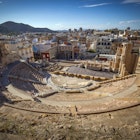
Remote volunteers discover archaeological sites galore in lockdown

May 28, 2020 • 2 min read

The red arrows show a probable Iron Age or Roman enclosed settlement and and the blue arrows show an associated field system, both hidden beneath woodland and revealed by LiDAR data © University of Exeter
While some people are spending their time in lockdown analyzing the latest Netflix has to offer, others are examining images more technical in nature – and they’re making archaeological discoveries by the dozen.
A team of remote volunteers working with the UK’s University of Exeter have combed through a battery of data-derived topographical maps of the Tamar Valley and found Roman, prehistoric, and medieval sites, all previously undocumented: parts of two Roman roads, 30-some prehistoric or Roman large embanked settlement enclosures, prehistoric burial mounds, and medieval farms, field systems, and quarries.

Part of the university’s Understanding Landscapes project, the effort relies on LiDAR (light detection and ranging) data that’s collected during aerial surveys and used to create detailed maps, without vegetation or buildings to get in the way. The laser technology, cross-referenced with historic maps and known archaeological records, lets armchair Indiana Joneses examine the shape of the land itself to spot any historical remains.
Though the project’s current focus is the Tamar Valley, its scope “has been extended to include a broad swathe of land between Bodmin Moor and Dartmoor, Plymouth and Barnstaple – about 4000 sq.km in all,” team lead Dr. Chris Smart said in a news release, adding that he expects his volunteers to find hundreds of new sites in the coming weeks if they continue on at this pace.

“Ordinarily we would now be out in the field surveying archaeological sites with groups of volunteers, or preparing for our community excavations, but this is all now on hold,” he said. “I knew there would be enthusiasm within our volunteer group to continue working during lockdown – one even suggested temporarily rebranding our project ‘Lockdown Landscapes’ – but I don’t think they realised how many new discoveries they would make.”
For Fran Sperring, a regular volunteer, there’s been “a fairly steep learning curve” but the work has been worthwhile. “Searching for previously unknown archaeological sites – and helping to identify places for possible future study – has been not only gratifying but engrossing,” she said in the release. “Archaeology from the warm, dry comfort of your living room – what could be better?”
You may also like:
Adventures close to home: exploring the world on your doorstep
7 beautiful botanic gardens you can tour from home
This home decor will transport you to the destinations of your dreams
Explore related stories


 ArchaeologyWhat does Chichén Itzá mean? Unveiling the name and history of this Maya wonder
ArchaeologyWhat does Chichén Itzá mean? Unveiling the name and history of this Maya wonderNov 10, 2024 • 8 min read

 Destination PracticalitiesHow to get your cell phone connected in Thailand: eSIMs, wi-fi and mobile networks
Destination PracticalitiesHow to get your cell phone connected in Thailand: eSIMs, wi-fi and mobile networksNov 27, 2024 • 7 min read


 Destination PracticalitiesEverything you need to know about getting around Barcelona
Destination PracticalitiesEverything you need to know about getting around BarcelonaNov 27, 2024 • 5 min read


